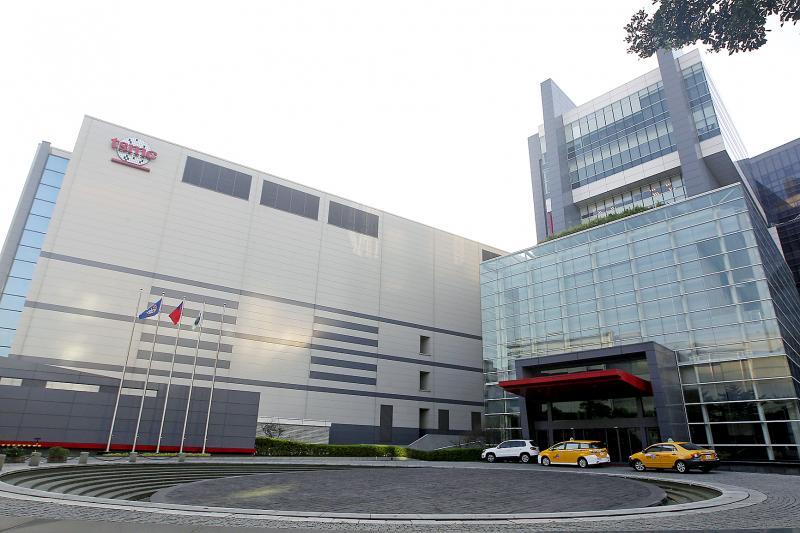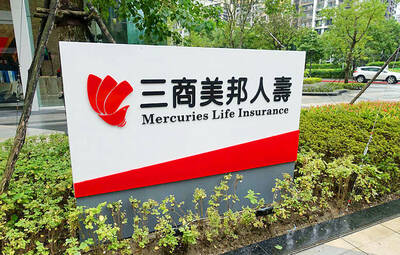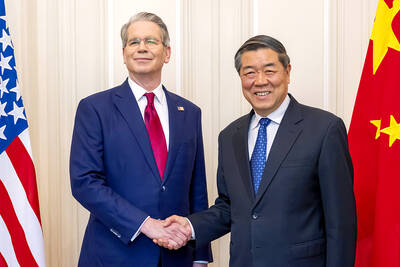As much as the US pines for the good old days of global semiconductor supremacy, Japan feels its loss of glory even more.
Once a dominant name in electronic components, the nation has been overtaken by Taiwan, South Korea, and, more recently, China. Yet Tokyo might have a viable plan to revitalize its domestic sector.
“Unlike the purely domestic, independent way it was done in the past, I think we need to cooperate with overseas counterparts,” Akira Amari, a former economy minister and senior member of the ruling Liberal Democratic Party, told Bloomberg News’ Isabel Reynolds and Emi Nobuhiro this week.

Photo: Pichi Chuang, Reuters
That is remarkable pragmatism for a country whose industrial policy has largely revolved around protecting and isolating its companies to preserve national identity. Yet three decades of decline show that past policies are just not cutting it.
In 1988, Japan commanded 50 percent of the global semiconductor industry, according to a presentation this month from the Japanese Ministry of Economy, Trade and Industry that cited data from research firm Omdia.
Back then, names such as NEC Corp, Toshiba Corp, Hitachi Ltd and Fujitsu Semiconductor Ltd occupied six of the top 10 places in market share, alongside US giants Intel Corp and Motorola Solutions Inc.
By 2019, Japan accounted for 10 percent. The US had climbed to 50 percent, due to the ascent of chip designers like Qualcomm Inc, Nvidia Corp and Advanced Micro Devices Inc.
These US firms rose thanks to a bifurcated business model aided by Taiwan Semiconductor Manufacturing Co (TSMC, 台積電), an anchor tenant in Taiwan’s noted science parks. The arrangement reflects complementary skill sets. Rather than both design and manufacture a chip, as was once the case, most US companies now just outsource to foundries like TSMC.
Amari said that TSMC is exactly the type of foreign partner that Japanese companies should work with, since it is the world’s largest maker of non-memory semiconductors.
His words carry weight, given that he is heading a party working group on chip strategy as part of Japanese Prime Minister Yoshihide Suga’s policy to incorporate industry plans into the government’s growth plans.
Japan remains a global leader in the equipment and materials used for production. As chips get increasingly more difficult to make, tighter integration across the supply chain is inevitable.
Taiwanese companies, including TSMC and United Microelectronics Corp (聯電), have a lot to offer.
The Taiwan-Japan relationship is also becoming one of the closest in East Asia. Tokyo last week donated 1.24 million doses of much-needed COVID-19 vaccine as Taipei struggles to contain an outbreak. They share close trade, cultural and tourism ties, and feel increasing economic and military tensions from Beijing.
The idea of semiconductor cooperation is not without precedent. More than a decade ago, Yukio Sakamoto, president of Japan’s then-largest memory chipmaker, Elpida Memory Inc, tried to rally together a consortium of local and Taiwanese companies to battle against industry giants Samsung Electronics Co and Micron Corp.
Japan’s semiconductor sector was already on the slide. Elpida was formed by the merger of memory divisions from NEC and Hitachi in 1999, a time when the nation’s share had already fallen below 30 percent.
Sakamoto did not think that either the Japanese or Taiwanese firms could survive on their own.
“We don’t have the scale,” he said in 2010.
Sakamoto’s proposal fell through amid opposition from Taiwanese companies and political pressure in Taipei. Within two years, his company had filed for bankruptcy and Taiwanese rivals largely exited the computer memory industry.
The mood is vastly different now. TSMC in February said it plans to set up a Japan research center primarily centered on materials development so that it can tap into the nation’s deep pool of chemical engineers.
The ministry hopes to take it further, and expects to offer strong incentives to lure a foreign chip foundry to Japan, Kazumi Nishikawa of the ministry’s IT Industry Division told Bloomberg News.
Politically, both governments are crucially aware of the need to cooperate, and jointly work with the US, to hold off China’s rising strength.
Chinese companies have increased their share of Apple Inc’s orders, a benchmark for the global electronics supply chain, and Beijing is willing to spend as much as it takes to ensure its chip industry gains traction.
Not content with being the king of chip design, the US now sees lack of manufacturing capacity as a threat to national security. Washington is looking to spend more than US$30 billion to get back in the game, increasing the urgency for other nations to cement their own plans.
With semiconductors becoming a key weapon in the technology cold war, Taipei and Tokyo would be smart to team up.
Tim Culpan is a Bloomberg Opinion columnist covering technology. He previously covered technology for Bloomberg News.
This column does not necessarily reflect the opinion of the editorial board or Bloomberg LP and its owners.

France cannot afford to ignore the third credit-rating reduction in less than a year, French Minister of Finance Roland Lescure said. “Three agencies have downgraded us and we can’t ignore this cloud,” he told Franceinfo on Saturday, speaking just hours after S&P lowered his country’s credit rating to “A+” from “AA-” in an unscheduled move. “Fundamentally, it’s an additional cloud to a weather forecast that was already pretty gray. It’s a call for lucidity and responsibility,” he said, adding that this is “a call to be serious.” The credit assessor’s move means France has lost its double-A rating at two of the

AI BOOST: Although Taiwan’s reliance on Chinese rare earth elements is limited, it could face indirect impacts from supply issues and price volatility, an economist said DBS Bank Ltd (星展銀行) has sharply raised its forecast for Taiwan’s economic growth this year to 5.6 percent, citing stronger-than-expected exports and investment linked to artificial intelligence (AI), as it said that the current momentum could peak soon. The acceleration of the global AI race has fueled a surge in Taiwan’s AI-related capital spending and exports of information and communications technology (ICT) products, which have been key drivers of growth this year. “We have revised our GDP forecast for Taiwan upward to 5.6 percent from 4 percent, an upgrade that mainly reflects stronger-than-expected AI-related exports and investment in the third

Mercuries Life Insurance Co (三商美邦人壽) shares surged to a seven-month high this week after local media reported that E.Sun Financial Holding Co (玉山金控) had outbid CTBC Financial Holding Co (中信金控) in the financially strained insurer’s ongoing sale process. Shares of the mid-sized life insurer climbed 5.8 percent this week to NT$6.72, extending a nearly 18 percent rally over the past month, as investors bet on the likelihood of an impending takeover. The final round of bidding closed on Thursday, marking a critical step in the 32-year-old insurer’s search for a buyer after years of struggling to meet capital adequacy requirements. Local media reports

RARE EARTHS: The call between the US Treasury Secretary and his Chinese counterpart came as Washington sought to rally G7 partners in response to China’s export controls China and the US on Saturday agreed to conduct another round of trade negotiations in the coming week, as the world’s two biggest economies seek to avoid another damaging tit-for-tat tariff battle. Beijing last week announced sweeping controls on the critical rare earths industry, prompting US President Donald Trump to threaten 100 percent tariffs on imports from China in retaliation. Trump had also threatened to cancel his expected meeting with Chinese President Xi Jinping (習近平) in South Korea later this month on the sidelines of the APEC summit. In the latest indication of efforts to resolve their dispute, Chinese state media reported that